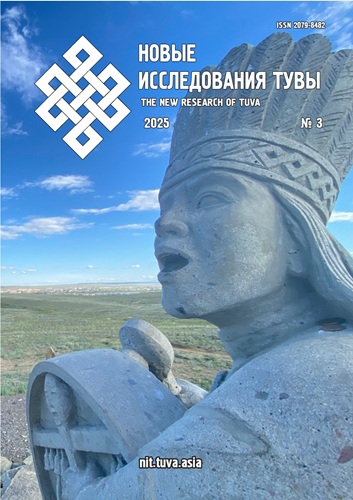Emotional bond between humans and domestic animals in Tuvan literature
DOI:
https://doi.org/10.25178/nit.2025.3.3Keywords:
Tuvan literature; emotion; emotional bond; feeling; horse; dogAbstract
The article examines the phenomenon of the emotional bond between humans and domestic animals, primarily horses and dogs, in Tuvan fiction. The authors emphasize that for Tuvans, animals were not only assistants in economic activities and sources of subsistence, but also loyal friends with whom a profound emotional connection was established. The loss or suffering of an animal was experienced as a personal tragedy, comparable to the loss of a family member.
The work analyzes the writings of Tuvan authors composed in both the Tuvan and Russian languages, in which various aspects of emotional interaction between humans and animals are revealed. Particular attention is given to plots that portray feelings of joy, grief, regret, and love, as well as descriptions of gestures of comfort and moments of recognition between a person and his or her animal companion. Examples from novels and short stories (such as “Kara-Bai” by E. T. Tanova, “Distant Echo” by E. L. Dongak, “Restless Ulug-Khem” by K. K. Kudazhy, among others) illustrate how horses and dogs become an integral part of the inner world of the protagonists, reflecting their emotions and experiences.
The article also considers the specific challenges of translating emotionally rich texts from Tuvan into Russian and highlights the role of bilingual authors capable of conveying emotional nuances through different linguistic systems. The authors conclude that fiction serves as a valuable source for studying the emotional dimension of human-animal interaction in traditional Tuvan culture.
References
Bakhtikireeva, U. M. (2009) Creative bilingual personality: features of the Russian text by an author of Turkic origin. 2nd ed. Astana, TsBO i MI. 282 p. (In Russ.)
Burykin, A. A., Boldyreva, I. M. and Muzraeva, D. N. (2019) The dog in Kalmyk and Tuvan folklore. New Research of Tuva, no. 4, pp. 119–132. (In Russ.). DOI: https://doi.org/10.25178/nit.2019.4.10
Davydov, V. N. (2018) Emotions in human, animal, and landscape relations: a study of coral-fishing labor in Taimyr. Kunstkamera, no. 2, pp. 81–87. (In Russ.) DOI: https://doi.org/10.31250/2618-8619-2018-2-81-87
Djambinova, N. S. (2023) The value of domestic animals in the axiological system and language of different peoples. In: Network Oriental Studies: Oriental Scientific Knowledge in the Modern Context. Proc. VI International Scientific Conference, Elista, October 26–27, 2023 / ed. by B. K. Salaev. Elista, Kalmyk State University named after B. B. Gorodovikov. 509 p. Pp. 75–80. (In Russ.)
Ivanov, E. E., Marfina, Zh. V. and Shkuran, O. V. (2022) Animal nominations in Tuvan proverbs and sayings: aspects of implementation and issues of research. New Research of Tuva, no. 1, pp. 47–68. (In Russ.) DOI: https://doi.org/10.25178/nit.2022.1.4
The history of Tuvan literature (2013) / A. S. Dongak, U. A. Dongak, M. A. Kuzhuget et al. Novosibirsk, Publishing House of the Siberian Branch of the Russian Academy of Sciences. Vol. I. 266 p. (In Russ.)
The history of Tuva (2001) / eds. S. I. Vainshtein and M. Kh. Mannai-ool. Novosibirsk, Nauka. Vol. 1. 376 p. (In Russ.)
The history of Tuva (2007) / eds. S. I. Vainshtein and M. Kh. Mannai-ool. Novosibirsk, Nauka. Vol. 2. 430 p. (In Russ.)
Kenin-Lopsan, M. B. (2017) Tuvan traditions. Parts I–II. Kyzyl, Tuvan Book Publishing House. 360 p. (In Tuvan). (In Russ.)
Kombu, S. S. (2013) “The Word of the Arat” by S. Toka — One of the Classical Works of Tuvan Literature: History of Creation. Vserossiyskii zhurnal nauchnykh publikatsiy, no. 1, pp. 62–63. (In Russ.)
Lamazhaa, Ch. K., Suvandii, N. D. and Mongush, A. V. (2023) The sacred in Tuvan culture: past and present. New Research of Tuva, no. 3, pp. 220–241. (In Russ.) DOI: https://doi.org/10.25178/nit.2023.3.14
Rakhimzhanov, K. Kh., Akosheva, M. K., Temirgazin,a Z. K. (2020) Metaphorical and metonymical interpretation of the heart in Kazakh and Tuvan: interaction of language, anatomy and culture. New Research of Tuva, no. 4, pp. 261–271. (In Russ.) DOI: https://doi.org/10.25178/nit.2020.4.18
Samdan, Z. B. (2020) Transformation of the image of the woman of nomadic culture in Tuvan literature (on the example of the works of A. M. Lamazhaa). New Research of Tuva, no. 3, pp. 228–239. DOI: https://doi.org/10.25178/nit.2020.3.16 (In Russ.)
Sodnompilova, M. M. (2019) Images of domestic animals in interpretations of the social structure of nomadic society. Izvestiya of Irkutsk State University. Series: Geoarchaeology. Ethnology. Anthropology, vol. 27, pp. 73–78. (In Russ.) DOI: https://doi.org/10.26516/2227-2380.2019.27.73
Soyan A.M. (2023) The image of the horse in Tuvan riddles. New Research of Tuva, no. 3, pp. 84–96. (In Russ.) DOI: https://doi.org/10.25178/nit.2023.3.6
Sukhanova, V. S. and Lykov, I. N. (2022) The influence of domestic animals on the psycho-emotional health of their owners. Tendentsii razvitiya nauki i obrazovaniya, no. 85-2, pp. 63–68. (In Russ.) DOI: https://doi.org/10.18411/trnio-05-2022-67
Tokareva, N. A. (2021) Turkicisms as means of creating national world images in contemporary fiction (on the material of the novel by Anna Lamazhaa “The Roads of the Silver Shamans”). In: National Images of the World in the Mirror of the Russian Language: Collected Papers / ed. by O. A. Valikova. Moscow, RUDN. 212 p. Pp. 206–212. (In Russ.)
Fedorovich, E. Yu. (2019) Three sides of the same attachment: people and their pets. Psikhologiya i psikhoterapiya sem'i, no. 3, pp. 5–18. (In Russ.) DOI: https://doi.org/10.24411/2587-6783-2019-10001
Shapinskaya, E. N. (2017) The animal image in cultural texts. Kultura kultury, no. 4 (16), article 5 [online] Available at: http://cult-cult.ru/the-animal-image-in-cultural-texts/ (accessed: 12.04.2025). (In Russ.)
Ybyrayym, A. O. and Altaeva, A. O. (2017) Animalistic images in the ethnoculture of the Tatar and Kazakh peoples. Tatarica, no. 1(8), pp. 7–21. (In Russ.)
Published
How to Cite
For citation:
Azyraa Sh. Yu., Buribayeva M. A. and Kengessova M. B. Emotional bond between humans and domestic animals in Tuvan literature. New Research of Tuva, 2025, no. 3, pp. 42-54. (In Russ.). DOI: https://doi.org/10.25178/nit.2025.3.3
Issue
Section

This work is licensed under a Creative Commons Attribution-NonCommercial 4.0 International License.

Author(s) license holder(s) grant rights for their work to the journal (grantee of a license) under the simple non-exclusive open license in accordance with Art. 1286.1 «Open license for a research work, work of literature or fine arts», Civil Code of the Russian Federation.
New Research of Tuva publishes articles under the Creative Commons Attribution-NonCommercial license (CC BY-NC).
Since it is an open license, author(s) reserve the right to upload the article to their institutional repository, submit it to another journal (if it allows republications), or republish it on their own website (in full, or in part).
However, several conditions apply here:
a) The republished version must always contain the name(s) and affiliation(s) of the author(s), the original title and the hyperlink to the original version on the New Research of Tuva website;
b) It must be in open access, free of charge, and no category of readers must be in any way whatsoever advantaged over general readership.
c) should the contribution be submitted elsewhere by its author(s) without substantial modification (30% or more of original text unchanged), the body of the article should contain a disclaimer that the original version was published in New Research of Tuva (with a link to the respective page)
The CC-BY-NC is a non-revocable license which applies worldwide and lasts for the duration of the work’s copyright.











